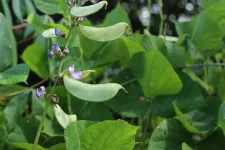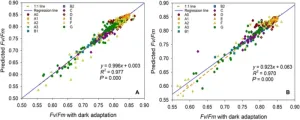(Press-News.org) Safer cancer drugs are now one step closer after a new study led by UCL (University College London) researchers found the likely reason that some treatments damage the heart.
Modern drugs can be very effective at treating cancer and have led to greatly improved survival rates. However, some cancer treatments can cause damage to the heart, or cardiotoxicity. This damage can present in a range of ways, from a slight change in the heart’s pumping ability to debilitating heart failure. But the ways in which these drugs cause damage have remained elusive.
Now an international study, funded by the British Heart Foundation (BHF) and published in the journal Science Advances, has identified proteins in the blood that are linked to an increased risk of developing heart diseases, including heart failure (where your heart can’t pump blood around your body as well as it should), and which are also affected by drugs used in cancer treatment.
The team say that their findings can explain how cancer drugs cause their damaging effects on the heart and could help to identify those at increased risk. In the long run, they believe this will help to improve cancer treatments, with new drugs potentially being developed that can shrink tumours without affecting the identified proteins.
In addition, the study reveals new potential drug targets for treating heart diseases including heart failure. These may work by inhibiting proteins linked to higher disease risk, or activating proteins linked to lower risk.
The researchers first performed a genome-wide association study, searching through the DNA of nearly 37,000 people without heart disease enrolled in the UK Biobank study. This identified genetic variants linked to changes to the structure and function of the pumping chambers of the heart – the ventricles.
Our genes contain the instructions needed to make proteins, the building blocks of the body. Using a technique called Mendelian randomisation, the researchers then pinpointed 33 proteins, coded for by these genetic variants, that are present in the blood and associated with the risk of developing several heart diseases. These included different types of heart failure, and atrial fibrillation (a common abnormal heart rhythm which increases the risk of stroke). Crucially, many of these proteins are the targets of drugs currently used to treat cancer.
Lead author Dr Floriaan Schmidt (UCL Institute of Cardiovascular Science) said: “The proteins identified in our study will help to accelerate future drug development, offering scientists a blueprint for new treatments for both cancer and heart diseases. This can help them to be more confident of the effects of the drugs that they design – whether that’s shrinking tumours without causing damage elsewhere or improving the heart’s pumping action.”
Professor Sir Nilesh Samani, Medical Director at the British Heart Foundation, said: “While there have been advances in treating cancer, one of the consequences has been a risk of heart damage from these drugs.
“This research points the way towards developing safer and more refined drugs so that, one day, worries about developing heart problems after cancer treatment might be a thing of the past.”
This research was also supported by the UKRI/NIHR Multimorbidity fund Mechanism and Therapeutics Research Collaborative and the Rosetrees Trust.
END
Cause of heart damage from cancer drugs identified
Safer cancer drugs are now one step closer after a new study led by UCL (University College London) researchers found the likely reason that some treatments damage the heart.
2023-04-28
ELSE PRESS RELEASES FROM THIS DATE:
Are the least social animals the most innovative?
2023-04-28
Innovating, i.e. the ability to find solutions to new problems or innovative solutions to known problems, it provides crucial benefits for the adaptation and the survival of human beings as well as for animals. What are the characteristics that make specific species or animals to be innovative? A study by the University of Barcelona has analysed this cognitive skill in ungulates, a group of mammals such as dromedaries, horses and goats, characterized by walking on the tip of their toes or hooves. The results show that those individuals that are less integrated ...
New bean genome unveils potential to boost food security and resilience in drought-prone regions
2023-04-28
NAIROBI, Kenya, 20 April 2023_An international team of researchers, led by Africans, has fully sequenced the genome of a climate resilient bean that could bolster food security in drought-prone regions.
The sequencing of the hyacinth bean or ‘lablab bean’ [Lablab purpureus] paves the way for wider cultivation of the crop, bringing nutritional and economic benefits, as well as much needed diversity to the global food system.
The plant is native to Africa and is cultivated throughout the tropics producing highly nutritious beans, which are used for food ...
El Niño–Southern Oscillation correlates well with following-summer cloud-to-ground lightning in China
2023-04-28
Large-scale circulation anomalies are a key factor in the transportation of water vapor and changes in climate. For tropical and subtropical regions, an atmospheric circulation field not only determines the characteristics of the weather situation but also influences the atmospheric circulation in the middle and high latitudes, as well as the global climate, through the transport of energy and angular momentum. At the same time, whilst lightning can serve as a global tropical “thermometer” and an indicator of water vapor in the upper troposphere, the driving role of the circulation situation for it needs to be further analyzed.
In a paper recently ...
An artificial intelligence method for rapid plant phenotyping under complex conditions
2023-04-28
During photosynthesis, the green pigment chlorophyll in algae and plants absorbs most of the energy from incoming light. Chlorophyll gets excited and transfers this energy to the energy-harvesting protein complexes photosystem I (PSI) and II (PSII). However, some of this energy dissipates as heat or chlorophyll a fluorescence (ChlF).
Changes in the environment or plant physiology that affect PSII also alter ChlF, which can therefore be used as a fast, sensitive, and non-destructive indicator of PSII status. Indeed, ChlF is a powerful tool for assessing multiple aspects of photosynthesis. Though ChlF measurements ...
Tip sheet: Studies on behavioral concerns tied to a commonly used chemical and youth COVID-19 vaccination rates among Johns Hopkins research to be featured at National Pediatrics Meeting
2023-04-28
FOR IMMEDIATE RELEASE
What: Pediatric Academic Societies (PAS) 2023 Meeting
When: April 27 to May 1
Where: Walter E. Washington Convention Center (801 Mt Vernon Pl NW, Washington, DC 20001)
Johns Hopkins Children’s Center researchers will present on numerous topics during the PAS 2023 meeting, including:
System-Level Approach to Improve First COVID-19 Vaccine Dose Uptake in a Primary Care Setting: The Value of Health Educators
Monday, May 1, 1 to 2:30 p.m. Eastern time
Convention Center: 204 C
Oral Abstract
COVID-19 vaccination rates among youth ...
Study shines light on impact of environment on neurocognitive outcomes
2023-04-28
To gain a clearer understanding of the differences between childhood cancer patients when it comes to the impact of radiation therapy on cognition, scientists at St. Jude Children’s Research Hospital studied the effect of their environment. Their work showed that children with supportive environments fared better than children living in neighborhoods with economic hardship. Those in areas with greater economic hardship had worse baseline and long-term cognitive outcomes. The results imply that policies and resources providing support at a neighborhood level ...
6% of nations provide for citizens in just, sustainable manner
2023-04-28
COLUMBUS, Ohio – Researchers at The Ohio State University have developed a framework for quantifying how well countries around the world are doing at providing adequate food, energy and water to their citizens without exceeding nature’s capacity to meet those needs.
They found that only 6% of 178 countries provide for all their citizens in an ecologically sustainable way in both carbon sequestration and water consumption.
The study found that while 67% of nations operate safely and sustainably in regard to water use, only 9% do in regard to carbon sequestration, ...
IVI begins clinical development of DuoChol oral cholera vaccine
2023-04-28
The International Vaccine Institute, an international organization with a mission to discover, develop, and deliver safe, effective, and affordable vaccines for global health, began clinical development of DuoChol, a new low-cost oral cholera vaccine (OCV) in capsule form. With funding support from the Wellcome Trust and the Swedish government, IVI is preparing to conduct a Phase I clinical trial of the vaccine in Sweden.
Scientists at the University of Gothenburg developed DuoChol, a dry formulation inactivated bacterial whole cell/cholera toxin B subunit OCV with a similar composition as the world’s first WHO-prequalified OCV, DUKORAL®. ...
Astronomers detect the closest example yet of a black hole devouring a star
2023-04-28
Once every 10,000 years or so, the center of a galaxy lights up as its supermassive black hole rips apart a passing star. This “tidal disruption event” happens in a literal flash, as the central black hole pulls in stellar material and blasts out huge amounts of radiation in the process.
Astronomers know of around 100 tidal disruption events (TDE) in distant galaxies, based on the burst of light that arrives at telescopes on Earth and in space. Most of this light comes from X-rays and optical radiation.
MIT astronomers, tuning past the conventional X-ray and UV/optical bands, have discovered a new ...
Old dogs with dementia sleep less deeply, just like people with Alzheimer’s
2023-04-28
In people with Alzheimer’s, the earliest symptoms are commonly disruptions in sleep rhythms. These include daytime sleepiness, showing agitation or confusion around dusk, staying awake longer, and waking up often at night. These changes are thought to result from damage to sleep-regulating areas in the brain. Alzheimer patients tend to spend less time in both REM (rapid eye movement) sleep, in which most dreaming occurs, and non-REM (NREM) sleep. But they show the greatest reduction in so-called slow-wave sleep (SWS) – a stage of non-dreaming deep sleep, characterized by slow ‘delta’ brain waves (0.1 to ...
LAST 30 PRESS RELEASES:
Making lighter work of calculating fluid and heat flow
Normalizing blood sugar can halve heart attack risk
Lowering blood sugar cuts heart attack risk in people with prediabetes
Study links genetic variants to risk of blinding eye disease in premature infants
Non-opioid ‘pain sponge’ therapy halts cartilage degeneration and relieves chronic pain
AI can pick up cultural values by mimicking how kids learn
China’s ecological redlines offer fast track to 30 x 30 global conservation goal
Invisible indoor threats: emerging household contaminants and their growing risks to human health
Adding antibody treatment to chemo boosts outcomes for children with rare cancer
Germline pathogenic variants among women without a history of breast cancer
Tanning beds triple melanoma risk, potentially causing broad DNA damage
Unique bond identified as key to viral infection speed
Indoor tanning makes youthful skin much older on a genetic level
Mouse model sheds new light on the causes and potential solutions to human GI problems linked to muscular dystrophy
The Journal of Nuclear Medicine ahead-of-print tip sheet: December 12, 2025
Smarter tools for peering into the microscopic world
Applications open for funding to conduct research in the Kinsey Institute archives
Global measure underestimates the severity of food insecurity
Child survivors of critical illness are missing out on timely follow up care
Risk-based vs annual breast cancer screening / the WISDOM randomized clinical trial
University of Toronto launches Electric Vehicle Innovation Ontario to accelerate advanced EV technologies and build Canada’s innovation advantage
Early relapse predicts poor outcomes in aggressive blood cancer
American College of Lifestyle Medicine applauds two CMS models aligned with lifestyle medicine practice and reimbursement
Clinical trial finds cannabis use not a barrier to quitting nicotine vaping
Supplemental nutrition assistance program policies and food insecurity
Switching immune cells to “night mode” could limit damage after a heart attack, study suggests
URI-based Global RIghts Project report spotlights continued troubling trends in worldwide inhumane treatment
Neutrophils are less aggressive at night, explaining why nighttime heart attacks cause less damage than daytime events
Menopausal hormone therapy may not pose breast cancer risk for women with BRCA mutations
Mobile health tool may improve quality of life for adolescent and young adult breast cancer survivors
[Press-News.org] Cause of heart damage from cancer drugs identifiedSafer cancer drugs are now one step closer after a new study led by UCL (University College London) researchers found the likely reason that some treatments damage the heart.





